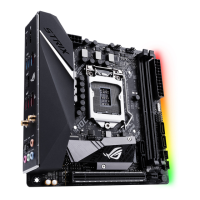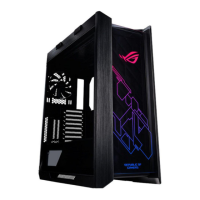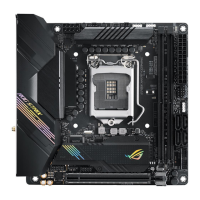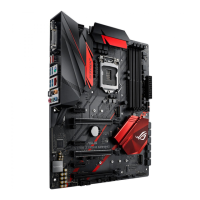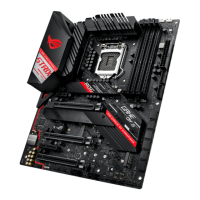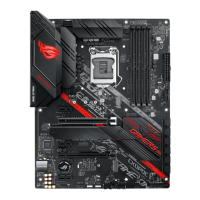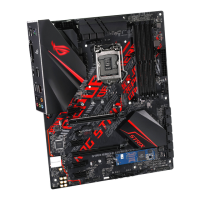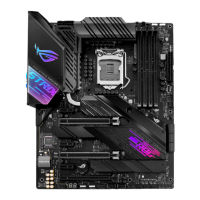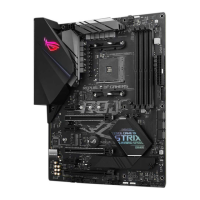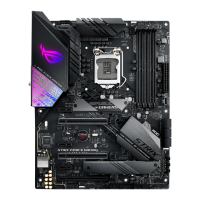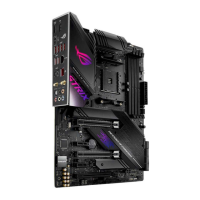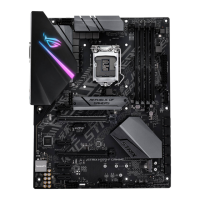
Do you have a question about the Asus ROG STRIX H370-F GAMING and is the answer not in the manual?
| Socket | LGA 1151 |
|---|---|
| Chipset | Intel H370 |
| Form Factor | ATX |
| Memory Slots | 4 |
| Maximum Memory | 64 GB |
| Memory Type | DDR4 |
| LAN | 1 x Gigabit LAN |
| RAID Support | RAID 0, 1, 5, 10 |
| Memory Speed | 2666MHz |
| PCIe 3.0 x16 Slots Configuration | x16, x4 |
| Storage Interface | SATA 6 Gb/s |
| Audio | 8-channel HD Audio |
| Networking | Intel I219-V |
| Audio Codec | SupremeFX S1220A |
Precautions to prevent electrical hazards during system operation and maintenance.
Guidelines for safe installation and handling of motherboard and components.
Overview of the manual's structure and content chapters.
Resources for additional information and product/software updates.
Explanation of text formatting conventions like bold, italics, and key notation.
Details on Intel Socket 1151, CPU support, and turbo boost technology.
Information about the Intel H370 Chipset.
Specifications for DDR4 DIMM slots, memory frequency, and XMP support.
Details on integrated graphics processor, multi-VGA output, and maximum shared memory.
Information on AMD 2-Way CrossFireX Technology support.
Specifications for PCIe 3.0 slots.
Details on M.2 sockets, SATA ports, and Intel Optane Memory readiness.
Details on Intel I219-V Gigabit LAN and ROG GameFirst Technology.
Specifications for ROG SupremeFX S1220A audio CODEC and features.
Details on USB 3.1 Gen 2, USB 3.1 Gen 1, and USB 2.0 ports.
List of proprietary ASUS ROG features and software.
List of ASUS exclusive features like Q-Design, SafeSlot, and DIGI+ VRM.
List of physical connectors on the rear panel.
List of internal connectors for fans, power, USB, and other components.
Information about BIOS flash ROM and supported features.
Details on WOL, WOR, and PXE manageability features.
List of included software and utilities for the motherboard.
Supported operating systems, specifically Windows 10 64-bit.
Dimensions of the motherboard (ATX Form Factor).
List of items included in the motherboard package.
List of cables provided with the motherboard package.
List of accessories included with the motherboard.
Information about the ROG motherboard support DVD.
Includes the user guide.
Provides an overview of the motherboard and its key features.
Diagram and labels for the motherboard's components and connectors.
Detailed information on installing the LGA1151 socket and CPU.
Details on DDR4 DIMM slots and recommended memory configurations.
Guidance on installing varying memory sizes and optimizing memory setup.
Information on installing PCIe x16 and PCIe x1 expansion cards.
PCI Express 3.0 operating modes for single VGA/PCIe cards.
Table showing IRQ assignments for various motherboard components.
Instructions for clearing CMOS memory using the CLRTC jumper.
Instructions for securing 3D printed parts using motherboard mount holes.
Explanation of Q LEDs (CPU, DRAM, VGA, BOOT) and Standby Power LED.
LEDs for diagnosing boot process issues.
Indicates system power status (ON, sleep, soft-off).
Details on internal connectors like SATA, front panel audio, and COM.
Connectors for SATA hard drives and RAID configuration options.
Connector for chassis-mounted front panel audio I/O module.
Connector for a serial port module, purchased separately.
Connector for a Trusted Platform Module (TPM) system.
Connectors for adding USB 3.1 Gen 1 front or rear panel ports.
Connector for USB 2.0 ports.
Connector for connecting the LED card under the motherboard back IO cover.
Connector for RGB LED strips.
Connectors for CPU_FAN, CHA_FAN, AIO_PUMP, and other fans.
Connector for thermistor cable to monitor temperature.
Sockets for installing M.2 SSD modules.
Connectors for ATX power supply plugs.
Connector for chassis-mounted functions like power LED, reset button.
Step-by-step instructions for installing the CPU onto the motherboard socket.
Instructions for installing CPU heatsink and fan assembly.
Procedure for mounting the motherboard into the PC chassis.
Steps for installing RAM modules into the DIMM slots.
Guide for connecting the main ATX power connectors.
Instructions for connecting SATA hard drives and SSDs.
Connecting front panel connectors for audio, USB, and LEDs.
Procedure for installing PCIe x16 and PCIe x1 cards.
Instructions for installing the FAN Extension card.
Instructions for installing an M.2 x4 card.
Steps for installing M.2 SSDs of different types.
Diagram and list of rear panel connectors.
Explanation of LAN port activity and speed LED status.
Mapping of audio ports for different channel configurations.
Diagrams showing audio connections for headphones, mics, and speakers.
Table of BIOS beep codes and their meanings.
Introduction to ASUS UEFI BIOS, its features, and CMOS settings.
How to enter BIOS Setup and general usage guidelines.
Overview of the Advanced Mode interface and its configuration options.
Explanation of the main menu items in the BIOS utility.
Details on highlighted menu items and submenus.
Option to select the display language for the BIOS.
Using the My Favorites feature to save BIOS settings.
Controlling fan speeds and profiles.
Using the EZ Tuning Wizard for RAID and overclocking.
Functionality to search for BIOS items.
Control for RGB LED lighting and functional LEDs.
Accessing BIOS FAQ via QR code.
Using scroll bars to navigate BIOS screens.
Description of selected BIOS items at the bottom of the screen.
Explanation of configurable and non-configurable fields.
List of navigation keys for BIOS setup.
Displays last modified and saved BIOS settings.
Overview of EZ Mode for basic system information and settings.
Setting fan profiles or manually configuring fan speeds.
Detailed steps for manually adjusting fan speed points.
Using EZ Tuning Wizard to set RAID and system overclocking.
Personal space for saving and accessing favorite BIOS items.
Instructions for adding BIOS items to the My Favorites screen.
Overview of system information and basic settings in the Main menu.
Menu items for changing system security settings and passwords.
Options for configuring overclocking-related settings.
Settings for CPU ratio, SpeedStep, and Turbo Mode.
Options for changing CPU and other system device settings.
Adjusting ASPM for PCH and SA PCI Express.
Shows CPU-related information and power management settings.
Adjusting Link Speed for PEG Port and Multi-Monitor.
Adjusting PCH PCI Express speed and configuration.
Configuring SATA devices, mode selection, and SMART self-test.
Enabling or disabling SATA devices.
Setting SATA mode to AHCI or RAID.
Monitoring system for hard disk errors during POST.
Changing USB-related features and single port control.
Configuring IPv4/IPv6 PXE support.
Displaying SMART information for connected devices.
Displaying system temperature/power status and fan settings.
Detecting lowest fan speed and configuring minimum duty cycle.
Controlling the water pump speed in DC or PWM mode.
Changing system boot options like Fast Boot and boot device priority.
Accelerates system boot speed.
Sets boot behavior after power loss.
Selects between Advanced Mode and EZ Mode for BIOS.
Configures CSM for better compatibility with VGA and bootable devices.
Selects boot device types (UEFI, Legacy).
Selects network device boot type.
Selects storage device boot type.
Selects PCI-E/PCI expansion device boot type.
Configures Windows Secure Boot settings.
Specifies boot device priority sequence.
Directly boots from a selected device.
Configures options for special functions.
Enables or disables the Setup animator.
Utility to run ASUS EZ Flash 3 for BIOS updates.
Safely cleans SSDs to restore factory performance.
Stores or loads multiple BIOS settings.
Views DRAM SPD information.
Displays information about installed graphics cards.
Shows graphics card info and recommended PCIe slot configuration.
Selects the bus interface for graphics cards.
Loads default values, saves, or discards changes.
Loads default BIOS settings for all parameters.
Saves selected values and exits the setup program.
Exits setup without saving changes.
Launches EFI Shell application from a filesystem device.
Instructions and warnings for updating motherboard BIOS.
Updates BIOS in Windows environment via internet.
Updates BIOS using a USB flash drive or internet.
Restores BIOS using DVD or USB if file is corrupted.
Steps to update BIOS using a USB flash drive.
Steps to update BIOS via internet connection.
Procedure to restore BIOS using DVD or USB drive.
Overview of Intel Rapid Storage Technology enterprise RAID levels.
Definitions for RAID 0, RAID 1, RAID 5, and RAID 10.
Guidelines for installing SATA HDDs for RAID.
Steps to enter and configure IRST in UEFI BIOS.
Step-by-step guide to creating a RAID volume in IRST.
Procedure to delete a RAID volume and its data.
Entering and navigating the IRST Option ROM utility.
Instructions for creating a RAID driver disk.
Steps to create a RAID driver disk during OS installation.
Federal Communications Commission Statement.
Device compliance statement for Canada.
Device compliance statement for Japan.
Warning statement for Korea.
Compliance with REACH regulations and disposal guidelines.
Information on ASUS recycling and takeback programs.
California warning about Cancer and Reproductive Harm.
License terms for Google products.
EU declaration of conformity statement for the device.
Contact details and technical support for ASUSTeK.
Contact details for ASUS America.
Contact details for ASUS Germany/Austria.
FCC Declaration of Conformity for the product.
